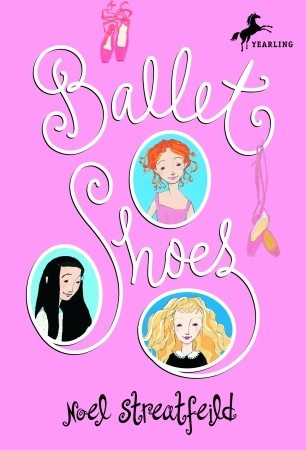 I first heard of "the shoe books" when Meg Ryan's character mentioned them in You've Got Mail. I sort of had them in the back of my mind as an option for Isabelle, so I was pleased when she picked out this book all on her own at the library.
I first heard of "the shoe books" when Meg Ryan's character mentioned them in You've Got Mail. I sort of had them in the back of my mind as an option for Isabelle, so I was pleased when she picked out this book all on her own at the library.
The whole set-up seems a bit contrived, but somehow, the author pulled it off.
I think the draw of the book is summed up in the very last line, when Petrova says, "I wonder... if other girls had to be one of us, which of us they'd choose to be?"
Would a little girl reading the book want to be Pauline, a beautiful actress with talent enough for stage and screen, but who, when it comes down to it, is not irreplaceable in her work? Someone who knows what she wants, but sacrifices it for the sake of her sister? (Granted, her sacrifice comes with the kind of opportunity dreams are made of, and you get the feeling she's going to be just fine.)
Or, would a reader choose to be Posy, a ballet prodigy whose talent was so remarkable that self-aggrandizing statements did not even come across as conceitedness because they were actually true? (I was intrigued by Petrova's ability to make that observation without quite being able to explain it, on page 140 of my paperback edition.)
Or, would a reader more often identify with Petrova, perhaps not with her fascination of motorcars and aeroplanes, but with her struggle to do what was expected of her, even though it did not interest her, while putting off her own dreams?
For me, I liked Petrova best. She did what she had to do to help her family, and even though she disliked it, she diligently did her work so that she became "technically one of the most proficient pupils in her class" (page 143). Still, she never lost sight of her true passions, and she optimistically held onto the possibility that one day she could do what she wanted for herself. Also, I liked that Petrova was smart and thoughtful and showed concern for others.
Throughout the book, I did wonder if - despite all the passages about hard work and long hours of practice - it might be glorifying show business? Petrova certainly provided a counterpoint to Pauline and Posy's talents and successes, but was it enough to let readers know that being a star isn't everything? I found it interesting, then, when Pauline said, towards the end of the book, "Film stars and dancers are nice things to be, but they aren't important." (page 231)
I liked that the girls were not perfect angels, and when they seriously misbehaved, they got dressed down for it. I also thought Pauline and Petrova were good role models in that they shared what little money they earned, and after putting some into savings, they were adamant about using what was left to help out with household expenses.
I wasn't sure if I wanted to give this book 4 or 5 stars, which is why I settled on 4 1/2 stars. It didn't jump out at me as a 5-star book, and yet, I really couldn't think of a good reason why it shouldn't be. Maybe I hoped the ending would be a bit less abrupt - everything was wrapped up nicely, but it was done awfully quick.
As it happened, Isabelle read this book and the first few Betsy-Tacy books around the same time. She gave the Betsy-Tacy books 4 stars, and Ballet Shoes 5 stars. But why? Is it because the girls in Ballet Shoes have special talents? Does she find the show business aspect fascinating? Is it because Ballet Shoes is more contemporary? More exciting? Or simply because the Fossil sisters are older than Betsy and Tacy so far in the books we've read? I don't know! It's interesting to see Isabelle's preferences and wonder what drives them.





